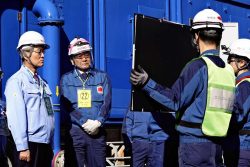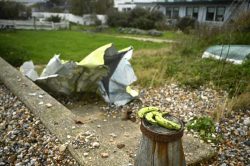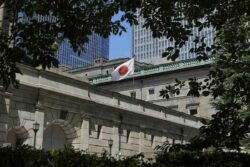16:03 JST, March 29, 2025
Thanks in part to the rain, the massive forest fires that have occurred in various parts of the country seem to be subsiding, but there is a risk that they will occur frequently in the future.
Once a fire breaks out, it spreads quickly and the area that is burned is extensive. Strict vigilance is required.
On March 23, forest fires broke out in Imabari, Ehime Prefecture, and Okayama City, both of which resulted in resident evacuations. In Imabari, damage to power transmission lines caused outages for more than 10,000 households. A wildfire also broke out in Miyazaki City on Tuesday.
The fires burned more than 400 hectares in Imabari and more than 500 hectares in Okayama City and its surrounding areas. A month earlier, a fire in Ofunato, Iwate Prefecture, burned 2,900 hectares.
More than 1,000 forest fires are reported nationwide annually, but the total area that is burned averages about 700 hectares per year. This highlights the extraordinary scale of this year’s fires.
Extreme dryness and strong winds are cited as factors.
Wildfires are more likely to occur from winter to spring due to accumulated fallen leaves on the mountains and dry air. In addition, this year, seasonal winds from China were strong, causing heavy snowfall on the Sea of Japan side, while on the other hand, dry winds blew over the mountains and crossed to the Seto Inland Sea and Pacific sides, exacerbating the dryness.
A maximum instantaneous velocity of nearly 15 meters per second was recorded in Imabari and Okayama City. The strong winds are believed to have intensified the fires. In the Imabari fire, the burned area doubled in just over a day.
Flying embers starkly demonstrated the terrifying nature of wildfires. Embers fanned by the wind jumped between distantly separated houses, spreading the damage. One cannot assume they are safe simply due to distance.
Many regions, such as depopulated areas, have inadequate systems to fight fires. Every effort must be made for early firefighting through broad regional cooperation to stop the fire from spreading while it is in its early stages.
The Defense Ministry has established the new Joint Operations Command to integrate the operations of the Ground, Maritime and Air Self-Defense Forces. This command should take the lead in directing firefighting and resident rescue operations to ensure their actions are effective.
Large-scale forest fires are occurring around the world. A massive fire that broke out in the suburbs of Los Angeles, Calif, in January resulted in numerous deaths.
South Korea has also experienced frequent forest fires recently, which resulted in over 20 deaths. A helicopter engaged in firefighting operations crashed. Japan must also be vigilant about secondary damage.
Temperatures around the world are high due to global warming. When the ground and air become dry, the risk of a fire starting and spreading increases. The threat of forest fires will likely continue. In Ofunato, fires that appeared to be extinguished reignited. It is hoped that the lessons learned will be shared and used in future firefighting efforts.
(From The Yomiuri Shimbun, March 29, 2025)
"Editorial & Columns" POPULAR ARTICLE
-

Violations of Subcontract Law: Major Automakers Must Eliminate Old Practices
-

Local Governments’ Tax Revenues: Devise Ways to Correct Imbalances in Tax Sources
-

Heavy Rains in Asia: Support for Victims, Flood-Control Measures Urgently Needed
-

5 Japanese Business Dinner Mistakes to Avoid — and What They Taught Me About Business in Japan
-

New Nuclear Threat: China Seeking to Follow U.S., Russia in Military Expansion
JN ACCESS RANKING
-

Keidanren Chairman Yoshinobu Tsutsui Visits Kashiwazaki-Kariwa Nuclear Power Plant; Inspects New Emergency Safety System
-

Imports of Rare Earths from China Facing Delays, May Be Caused by Deterioration of Japan-China Relations
-

University of Tokyo Professor Discusses Japanese Economic Security in Interview Ahead of Forum
-

Japan Pulls out of Vietnam Nuclear Project, Complicating Hanoi’s Power Plans
-

Govt Aims to Expand NISA Program Lineup, Abolish Age Restriction




















